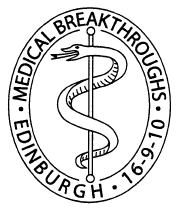Battle
Norvic Philatelics - GB New
Stamps and Special Postmarks
Medical Breakthroughs - 16
September 2010
A
set of 6 stamps celebrating six of the most significant medical
breakthroughs from the 20th century.
The United Kingdom has been at the forefront of medical research and
technology since William Harvey first described the circulation of the
blood in 1628. British physicians and scientists can justly take credit
for the discovery and application of smallpox vaccination, anesthetics,
anti-septic surgery and many public health measures, but perhaps some
of the most important breakthroughs have taken place in the last 120
years. We understand that a retail booklet will be issued in
January 2011 containing two of these 1st class stamps, with 4 gold
Machin definitives.
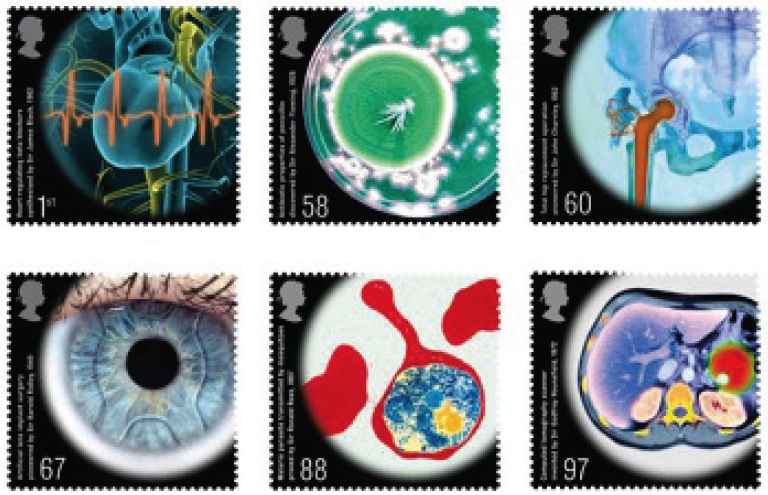
|
|
|
Set
of 6 stamps:
1st - Heart-regulating
beta-blockers (Inferior
anterolateral view (left side) of the heart and its major blood
vessels)
58p Antibiotic properties
of penicillin (Petri dish
culture penicillum notatum)
60p Total hip replacement
(Coloured X-ray of the pelvis of a 74 year old woman)
67p Artificial lens
implant surgery (Intraocular
lens, an artificial implanted lens placed in the eye surgically)
88p Link between Malaria
and mosquitoes (Coloured
transmission electron micrograph of a section through a
misshapen red
blood cell infected with a malaria parasite (Plasmodium
sp.))
97p Computed tomography
scanner (CT scan of
an axial section through a patient’s abdomen showing a false
aneurysm (red) due to chronic pancreatitis)
|
Brief descriptions - stamp by
stamp
1st Class –
Heart-regulating beta-blockers synthesized by Sir James Black 1962
Beta blockers are used for various indications, but particularly for
the management of cardiac arrhythmias, cardioprotection after
myocardial infarction (heart attack), and hypertension. Propranolol was
the first clinically useful beta adrenergic receptor antagonist.
Invented by Sir James W. Black in the late 1950s, it revolutionized the
medical management of angina pectoris and is considered to be one of
the most important contributions to clinical medicine and pharmacology
of the 20th century.
58p – Antibiotic
properties of penicillin discovered by Sir Alexander Fleming 1928
The discovery of penicillin
is attributed to Scottish scientist and Nobel laureate Alexander
Fleming in 1928 He showed that, if penicillium notatum was grown in the
appropriate substrate, it would exude a substance with antibiotic
properties, which he dubbed penicillin. This serendipitous observation
began the modern era of antibiotic discovery
60p – Total hip
replacement operation pioneered by Sir John Charnley 1962
Sir John Charnley began his
research into hip replacement in 1949 when he moved his clinical
practice as an orthopedic surgeon to Wrightington Hospital near Wigan.
While suffering many setbacks during its development Charnley finally
performed the first successful hip replacement operation in 1962. This
subsequently became the gold standard treatment for this condition and
has remained the most successful surgical and radiological procedure up
to the present day.
67p
– Artificial lens implant surgery pioneered by Sir Harold
Ridley 1949
Whilst working with Royal Air
Force casualties during World War II, Ridley noticed that when
splinters of perspex from aircraft cockpit canopies became lodged in
the eyes of wounded pilots, they did not trigger rejection, leading him
to propose the use of artificial lenses in the eye to correct cases of
cataracts. He had a lens manufactured using an identical plastic
– Perspex CQ made by ICI – and on 29 November 1949
at St Thomas’ Hospital, Harold Ridley achieved the first
implant of an intraocular lens.
88p
– Malaria parasite transmitted by mosquitoes proved by Sir
Ronald Ross 1897
In 1897, Ronald Ross discovered the presence of the malarial parasite
within a specific species of mosquito, the Anopheles. He initially
called them dapple-wings and following the hypothesis of Sir Patrick
Manson that the agent that causes malaria was spread by the mosquito,
he was able to find the malaria parasite in a mosquito that he
artificially fed on a malaria patient. Later using birds that were sick
with malaria, he was able to ascertain the entire life cycle of the
malarial parasite, including its presence in the mosquito’s
salivary glands. He demonstrated that malaria is transmitted from
infected birds to healthy ones by the bite of a mosquito, a finding
that suggested the disease’s mode of transmission to humans.
97p
– Computed tomography scanner invented by Sir Godfrey
Hounsfield 1971
While on an outing in the country, Hounsfield came up with the idea
that one could determine what was inside a box by taking X-ray readings
at all angles around the object. Hounsfield built a prototype head
scanner and tested it first on a preserved human brain, then on a fresh
cow brain from a butcher shop, and later on himself. In September 1971,
CT scanning was introduced into medical practice with a successful scan
on a cerebral cyst patient at Atkinson Morley Hospital in Wimbledon,
London.
Technical details:
Designed by Howard Brown the six 37 x 35mm stamps are printed in
lithography
by Cartor Security Printing. Perforations are 14 x
14½ and phosphor is 'all-over'.
Photographic credits: Inferior anterolateral view (left side)
of the heart and its major blood vessels: ©
MedicalRF.com/Corbis, Petri dish culture penicillum notatum: Wellcome
Photo Library, Wellcome Images, Coloured X-ray of the pelvis of a 74
year old woman, showing hip replacement: Dr P. Marazzi/Science Photo
Library, Intraocular lens, an artificial implanted lens placed in the
eye surgically: Helen Mcardle/Science Photo Library, Coloured
transmission electron micrograph of a section through
a misshapen red blood cell infected with a malaria parasite (Plasmodium
sp.): Dr Tony Brain/Science Photo Library, Coloured computed tomography
(CT) scan of an axial section through a patient’s abdomen
showing a false aneurysm (red) due to chronic pancreatitis: Du Cane
Medical Imaging Ltd/Science Photo Library.
All
images are by kind permission of Royal Mail, Copyright 2010.
This website is copyright Norvic Philatelics 2010.
Products
issued
Mint
set
Royal Mail FDCs
Presentation Pack
Set of 6 Stamp Cards
Special
Postmarks
Postmarks available for the day of issue will be shown here, others
will be
added later. These are
not to scale. These
postmarks cannot
be obtained after the date of issue.
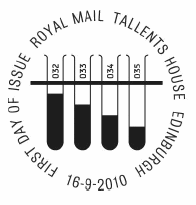 |
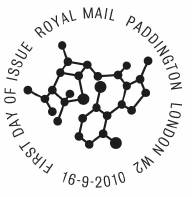 |
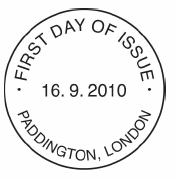
|
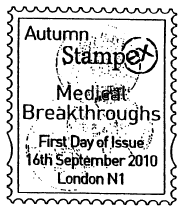
|
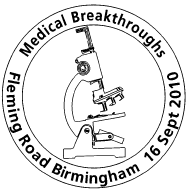
|
Ref FD1031
Philatelic Bureau Official Postmark illustrated with life-saving
equipment. |
Ref FD1032
Paddington official postmark |
Ref FD1032NP
Paddington Official non-pictorial Postmark |
Ref L11866
Autumn Stampex, London N1 First Day of Issue |
Ref M11858
Fleming Road, Birmingham |
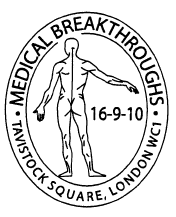 |
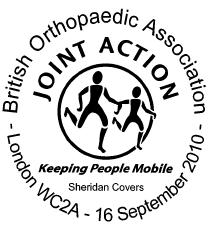
|
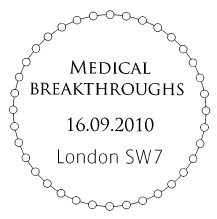
|
|
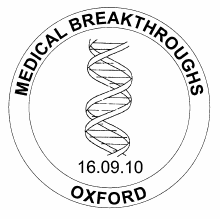
|
Ref L11852
Tavistock Square, London WC1 |
Ref L11850 Joint Action
- British Orthopaedic Association, London WC2 |
Ref L11849
London SW7 |
Ref S11863 - Edinburgh |
Ref L11869 - Oxford |
This page updated 7 September
2010
If
you wish to be told when this page is updated, please use the
ChangeDetection box at the top of this page.
If you have any questions,
please
email
us.
NB:
all emails will be
acknowledged in 1-2 days unless we are away (see home page). If you
do not receive an acknowledgement please email us from a different
address (eg hotmail, gmail).









